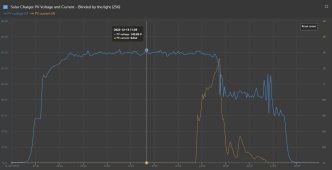sunshine_eggo
Happy Breffast!
Looking at Victron app, the V max for this array today was 116.07V, that's the highest of the week. Adding another panel would be getting close, but still safely under 150V I think. I'm not planning on risking it, I'll most likely make two 36V arrays from 6 panels to be safe. But just theoretically it looks like 6 panels would be doable while still keeping the voltage below 150V.
116.07V was the peak of the day while there was no charging?



